#princess wilhelm of prussia
Photo
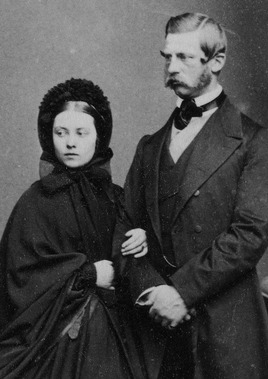

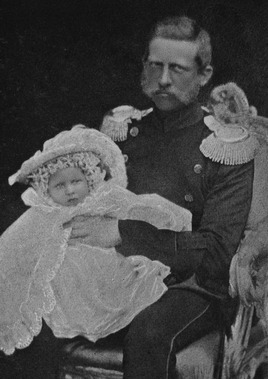



27 January 1859 | Birth of Kaiser Wilhelm II
The husband of the young mother provides us with a poignant portrayal of her intense suffering. After Martin had examined the Princess, Fritz asked him for a full and frank account of what could be expected. Martin explained that while Vicky’s life was not in danger, that of her child was. Fritz thereupon instructed the doctors ‘only to think of the mother, but was informed that it was medical practice to try save both mother and child’. The Prince nevertheless prepared himself ‘to witness the birth of a stillborn child’. He vividly describes the pitiful condition of the mother, who was unware of how dangerous the situation was for her baby:
Vicky’s pain, as well as her horrible screams and wails, became ever more severe; however, whenever she was granted a respite from her suffering, she would ask for forgiveness from everyone for her screaming and impatience, but she could not help herself. When the final stage of labour began, I had to try with all my might to hold her head in place, so that she would not strain her neck over much. Every contraction meant a real fight between her and me, and even today [29 January] my arms still feel quite weak. To prevent her from gnashing & bitting, we made sure there was a handkerchief in her mouth at all times. Occasionally I had to use all my strengh to remove her fingers from her mouth, & also place my own fingers in her mouth. With the strength of a giant, she was at times able to hold off 2 people, & thus the awful torture escalated until the moment of birth was so near that complete anaesthesia with chloroform was undertaken... Vicky was laid at right angles on the bed; she let forth one horrible, long scream, & was then anaesthetised.’
Fritz describes how, upon hearing not a cry from the newborn, he sank ‘in a half-faint’ onto the bed next to Vicky, whom he had been holding in his arms during the entire ordeal. Martin’s tone of voice as he uttered the words ‘It’s a prince’ seemed to confirm the father’s worst fears, and Fritz thought that what the doctor meant was: ‘such a shame - a boy on top of everything else’, until suddenly heard the child crying in the next room. ‘The sound cut through me like an electric shock; Martin said I should go in, Countess Perponcher took Vicky in her arms, & I staggered, in a half-faint, into the next room where the baby was in the bath, & first I fell into Mama’s arms, & then I sank to my knees. The baby cried again when he was given a further number of slaps, and everything seemed to indicate that all was well, indeed, wonderful, & I was assured that he would live!’
Young Wilhelm: The Kaiser’s Early Life by John C. G. Röhl.
#kaiser frederick iii#empress victoria#victoria princess royal#prussia#kaiser wilhelm ii#vicky was barely eighteen#when she went through this birth trauma#thank god she had fritz#*whatta man* starts playing#what a man what a man what a man#what a mighty good man
153 notes
·
View notes
Text

The German Crown Princess and Princess; Frederick and Victoria, The Princess Royal (daughter of Queen Victoria and Prince Albert).
Against their contemporaries of the German Empire, the couple shared liberal views and believed in a constitutional monarchy for Germany. Against the antisemitism of the time, the couple strongly supported the Jewish population of the German Empire regularly visiting synagogues when violence annd and antisemitism against Jewish people was increasing. Especially in the 1880s when a quarter of a million Germans signed a petition demanding Jewish people be banned from public office. Victoria wrote of her disgust of these leaders and her new nation who “behave so hatefully towards people of a different faith and another race who have become an integral part (and by no means the worst) of our nation!" This along with their other liberal beliefs heavily ostracised them from the conservative German court including Frederick’s parents. In contrast her mother, Queen Victoria, was proud of her daughter and son-in-law's efforts to stop the völkisch campaign and wrote to Frederick to say she was happy that her daughter had married a man like him, who was prepared to stand up for the rights of the Jews. Unfortunately for Frederick he would only become Emperor for 99 days due illness. Their son against their knowledge had been educated by a tutor with conservative views which meant their idea of constitutional monarchy would not come to fruition. The majority of their papers were saved having been sent to Windsor Castle before their son could destroy them. As Dowager she was heavily critical of her son who had purged all institutions of people chosen by Victoria and her late husband. When her son, Wilhelm II now the emperor (and last) wrote in the guestbook of the city of Munich the words "Suprema lex regis voluntas" (The will of the king is the supreme law"), she indignantly wrote to her mother; “The Tsar, an infallible Pope, a Bourbon or our poor Charles I might have pronounced that phrase, but a monarch of the 19th century ... My God, I think (...) Fritz's son and the grandson of my dear father took such a direction and also misunderstood the principles with which it is still possible to govern.”
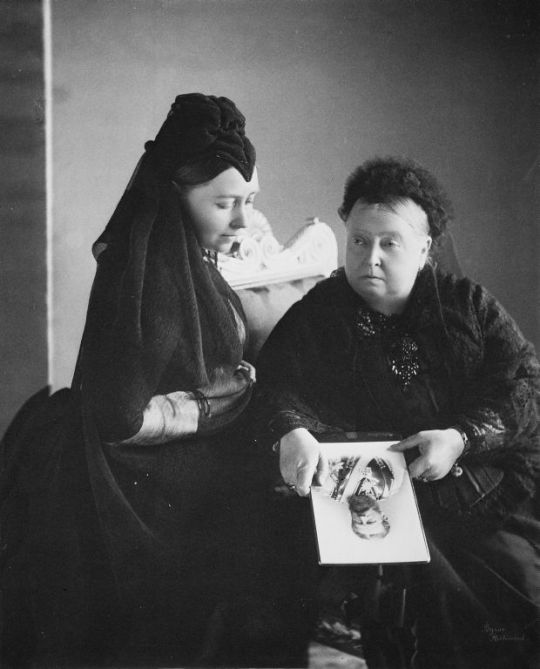
#ktd#british royal family#brf#Victoria princess royal#Queen Victoria#Jewish history#World history#wilhelm ii#frederick iii#Empress of Prussia
17 notes
·
View notes
Text
The 8 children of Emperor Fredrick III of Germany and Victoria Princess Royal (edit)
Wilhelm, Charlotte, Henry, Sigismund, Viktoria, Waldemar, Sophia, Margaret
(made by me using iMovie)
#should I do more of these edits?#haha I have already started making more 🤫#🩷🩵🤍#my edit#edits#video edit#prussian royal family#emperor Fredrick iii#kaiser Fredrick iii#fredrick iii#germany#kaiser wilhelm ii of germany#kaiser wilhelm ii#Victoria princess royal#crown princess victoria of Prussia#empress Fredrick of Germany#empress victoria of germany#empress of germany#princess charlotte of prussia#duchess of saxe meiningen#prince Henry of prussia#prince heinrich of prussia#prince sigismund of prussia#princess viktoria of prussia#viktoria of Schaumburg lippe#prince Waldemar of Prussia#waldemar of prussia#princess Sophie of Prussia#queen Sophie of Greece#Princess Margaret of Prussia
27 notes
·
View notes
Text
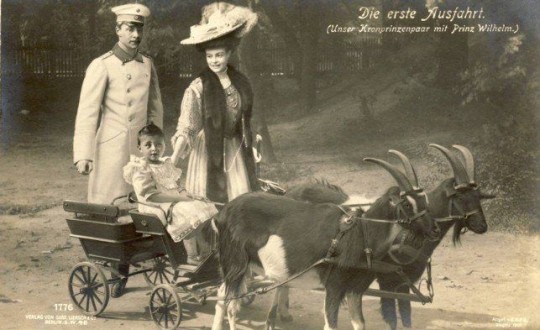
Crown Prince Wilhelm of Prussia with his wife Crown Princess Cecilie and their eldest son, Prince Wilhelm of Prussia.
#crown prince wilhelm of prussia#crown princess cecilie of prussia#prince wilhelm of prussia#german imperial family#prussian royal family#german history#house of hohenzollern
20 notes
·
View notes
Text
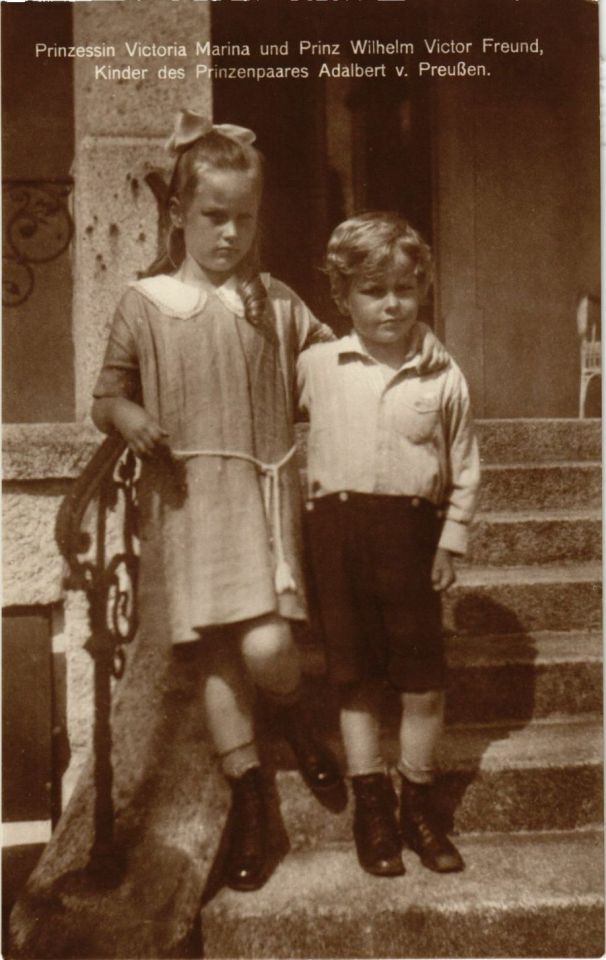
Princess Victoria Marina Cecilie of Prussia and Prince Wilhelm Viktor Ernst Freund Friedrich Georg Adalbert of Prussia
German vintage postcard
#princess#tarjeta#postkaart#german#adalbert#sepia#prussia#cecilie#wilhelm#georg#historic#photo#freund#postal#briefkaart#friedrich#photography#prince#ernst#vintage#ephemera#ansichtskarte#wilhelm viktor ernst freund friedrich georg adalbert#old#postcard#postkarte#victoria#viktor#carte postale#marina
3 notes
·
View notes
Photo
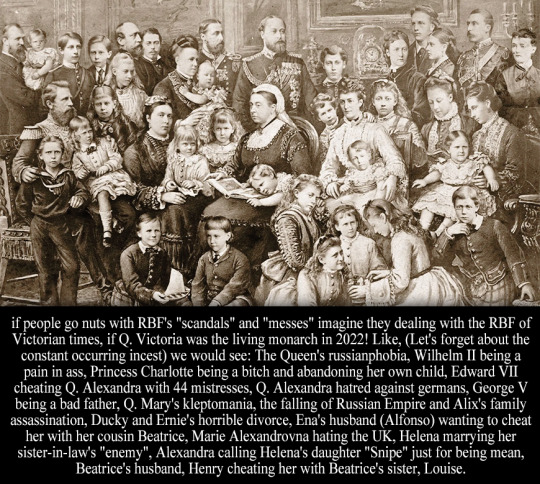
“if people go nuts with RBF's "scandals" and "messes" imagine they dealing with the RBF of Victorian times, if Q. Victoria was the living monarch in 2022! Like, (Let's forget about the constant occurring incest) we would see: The Queen's russianphobia, Wilhelm II being a pain in ass, Princess Charlotte being a bitch and abandoning her own child, Edward VII cheating Q. Alexandra with 44 mistresses, Q. Alexandra hatred against germans, George V being a bad father, Q. Mary's kleptomania, the falling of Russian Empire and Alix's family assassination, Ducky and Ernie's horrible divorce, Ena's husband (Alfonso) wanting to cheat her with her cousin Beatrice, Marie Alexandrovna hating the UK, Helena marrying her sister-in-law's "enemy", Alexandra calling Helena's daughter "Snipe" just for being mean, Beatrice's husband, Henry cheating her with Beatrice's sister, Louise.” - Submitted by Anonymous
#british royal family#Queen Victoria#Edward VII#queen alexandra#Princess Charlotte of Prussia#wilhelm ii#King George V#queen mary#empress alexandra feodorovna#princess victoria melita#Queen Victoria Eugenie#princess helena of the united kingdom#popular
71 notes
·
View notes
Text

#kaiser wilhelm ii#wilhelm ii#princess charlotte of prussia#princess charlotte#german empire#imperial germany#german monarchy#monarchy#prussian royal family#prussian#german royalty#history
3 notes
·
View notes
Text
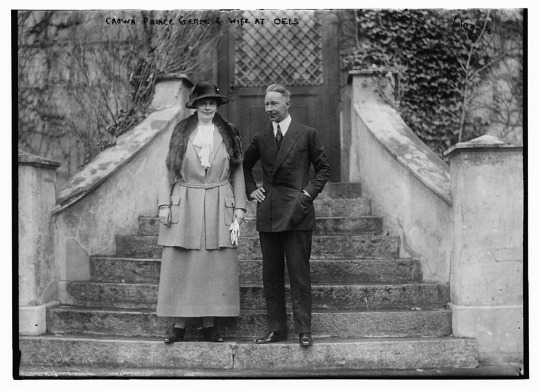
A rare photo of the exiled Crown Prince Wilhelm and Crown Princess Cecilie of Prussia in the early 1920s.
14 notes
·
View notes
Photo

During his Majesty's brief sojourn at Friedrichshof he and the German Emperor were the guests of Princess Frederick Charles of Hesse-Cassel, the youngest daughter of the late Empress Frederick. Her Royal Highness, who is the Kaiser's favourite sister, is a gentle, sweet-looking woman, who lives up to the Hohenzollern ideal by being the mother of six sturdy sons, who include two sets of twins. Princess Margaret of Prussia, as she was, of course, always called as a girl, played in her mother's life much the same part as Princess Beatrice played in that of our late Sovereign. It was said that on several occasions, she refused brilliant offers of marriage rather than leave her widowed mother, and her betrothal to the Prince whose wife she now is was the outcome of quite a romance. Prince Frederick Charles is a clever studious officer; he is trebly connected with our Royal Family, for in addition to being King Edward's nephew by marriage, he first-cousin to Queen Alexandra and to the Duchess of Connaught. The Empress Frederick left her youngest daughter the beautiful palace created by herself, and accordingly Prince and Princess Frederick Charles spend the greater portion of each year at Friedrichshof, though they also own a delightful suite of rooms in the famous Schloss Rupenheim.
The Sketch Aug 22, 1906
#Princess Margaret of Prussia#1900s#prussian royal family#Kaiser Wilhelm II#Prince Friedrich Charles of Hesse-Cassel#magazine article
15 notes
·
View notes
Photo

1908 Postcard: Prince August Wilhelm of Prussia and his bride Princess Alexandra Victoria of Schleswig-Holstein-Sonderburg-Glücksburg (by Gustav Liersch & Co.)
(Wernigerode Castle)
127 notes
·
View notes
Text
A Prussian at Napoleon's court
Friedrich Wilhelm Ernst Freiherr von Knobelsdorff was a Prussian officer and high-ranking diplomat who had been for some time ambassador in Constantinople. In 1804, he was sent as King Friedrich Wilhelm III’s special envoy from Berlin to Paris for Napoleon’s coronation ceremonies. This is a report he wrote back home, translated from Publicationen aus den k. Preussischen Staatsarchiven, Volume 29. The original is, of course, in French.
Sojourn in Fontainebleau. Knobelsdorff's report. Paris 28 November 1804
I believe it is my duty to report to Your Majesty some details of my stay at Fontainebleau, as the extraordinarily distinguished manner in which I was treated there can only be seen as a public mark that the Emperor of the French wished to bestow on a man who has the honour of being entrusted with a special commission from Your Majesty.
On the morning of the 26th I received a letter from Marshal Berthier inviting me, in the name of the Emperor, to go to Fontainebleau the next day to go hunting with the sovereign; I am the only foreigner and member of the diplomatic corps to have received such an invitation.
All the others donated candles in the castle chapel in relief because they did not have to expose themselves to this mortal danger. - Okay, so Knobelsdorff did not write that. But I still bet it’s true.
I arrived at Fontainebleau at eight in the morning on the 27th and was asked to go to the château for breakfast at 9.30. My wife was invited to have breakfast with the Empress. The Grand Marshal showed me the carriage by which I would be taken to the place in the forest where the hunt was to begin, and the Master of the Horse handed me a paper containing the names of five of the Emperor's horses which would be at my disposal.
Caulaincourt also likely warned him that if on Knobelsdorff’s return the slightest harm had come to any of these five horses, Knobelsdorff would regret it for the rest of his life.
My carriage was immediately in front of the Emperor's, and Marshals Soult, Ney and General Duroc were travelling with me.
Ney and Soult together in one carriage, huh?
Knobelsdorff to Duroc: Oh, Your Excellency will also join us in the carriage?
Duroc (patting down both Soult and Ney, confiscating all sharp objects): Yepp. Somebody has to babysit these other two excellencies, you know.
They forced me to take a seat at the back, [...]
Duroc: Sit here. Don’t move. If any of these two as much as twitches, warn me!
[…] while my wife was in the Empress's carriage, who was kind enough to give her a seat between herself and Princess Joseph.
On our return from the hunt, Mme de La Rochefoucauld invited us to dine with the Empress; as we sat down for dinner, the Emperor asked me to sit next to the Empress, opposite him. After dinner, two games of whist were arranged; the Emperor, who does not usually play cards, was kind enough to play with my wife, and I had the honour of playing with the Empress.
I hope Josephine was also kind enough to loose to the husband what Napoleon won through cheating from the wife.
After the game, which hardly lasted more than half an hour, the Emperor spoke in a very interesting way about his campaigns in Egypt and spoke more particularly with me about the present situation of the Ottoman Empire; at about ten o'clock in the evening the Emperor and the Empress retired, and I left the same night for Paris...
So, somewhat more seriously: This report was not put in chiffres, so it was part of the official correspondence that could easily be intercepted by the French and read in Lavalette’s Cabinet noir. That alone guaranteed that Knobelsdorff would have nothing but praise for how he was treated by this newly minted emperor and his makeshift court. But it is still interesting how friendly relations between France and Prussia had been ever since Prussia dropped out the coalition against revolutionary France, and how10 years later the Prussians would claim to be France’s arch-nemesis.
But mostly I like to see Soult and Ney in that carriage together, apparently stille quite at ease with each other and maybe even on friendly terms by 1804.
#napoleon's court#napoleon's marshals#geraud christophe michel duroc#michel ney#jean de dieu soult#paris 1804
38 notes
·
View notes
Photo
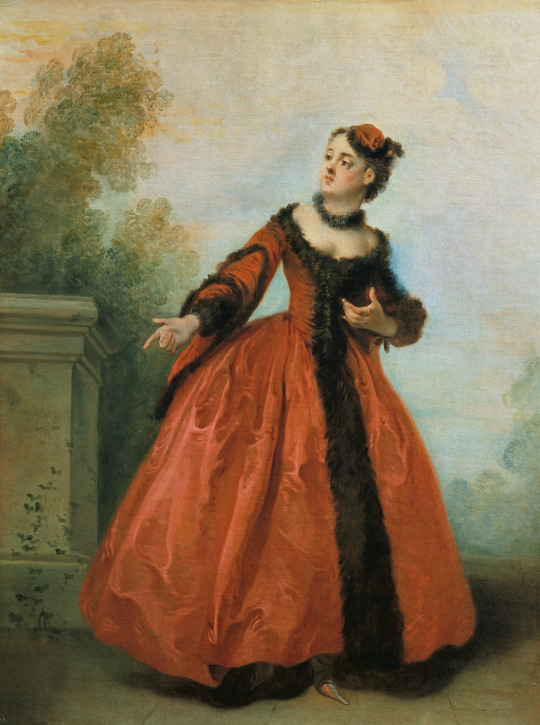




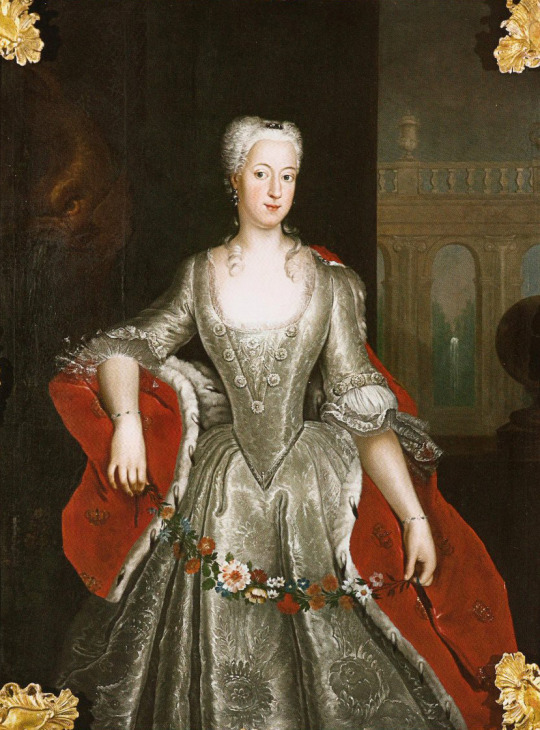
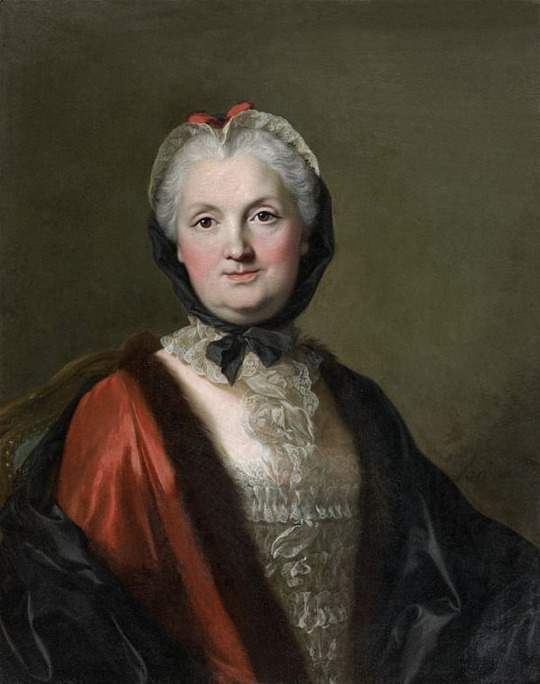
Early 1730s dresses and portraits (from top to bottom) -
ca. 1732 The Beautiful Greek (La Belle Grecque) by Nicolas Lancret (Wallace Collection - London, UK). From their Web site 1429X1960, The complex sleeves open at the top like they would in Russian court dresses a century later.
ca. 1732 Watson-Wentworth and Finch Families by Charles Philips (Yale Center for British Art, Yale University - New Haven, Connecticut, USA) persons. From Wikimedia 4902X3094. The décolletage-filling fichu would become prominent in the Louis XVI era, but just about every grown up woman wears one along with a fastened bodice, round skirt, and apron. The heads of every female are covered by a cap, veil, or hat.
1733 Marie-Geneviève le Tonnellier de Breteuil by French school (attributed to Alexis Simon Belle) (auctioned by Sala de Ventas).From invaluable.com/auction-lot/18th-century-french-school-alexis-simon-belle-a-646-c-2074af1b03 1940X3362.Round skirts flourish on both shores of the channel.
ca. 1730-1735 Lady by Joseph Highmore (National Gallery of Art - Washington, DC, USA). From their Web site 1148X1495. The cuffed outer sleeves are stuffed by under-sleeves and the dress lining has a very subdued pink contrasting with the gold color of the other layer.
1734 Princess Sophie Dorothea with Friedrich Wilhelm by Antoine Pesne (location ?). From Wikimedia1633X2611. Textiles with large patterns characterize the early 1700s. Her dress has a square neckline.suggesting French influence.
ca. 1734 Wilhelmine of Prussia, Margravine of Brandenburg-Bayreuth by Antoine Pesne (location ?). From Wikimedia 829X11221. The silver brocade over-bodice has a deep V neckline filled in with scoop neckline.
1734 Madame Marie du Tour Vuillard (1695- 1759), née Robin by Louis Michel Van Loo (Tajan - 12-12-12 auction Lot 37), From their Web site; fixed spots & flaws w Pshop 2487X3151.
#1730s fashion#Georgian fashion#Louis XV fashion#Rococo fashion.#The Beautiful Greek#Nicolas Lancret#fur-trimmed dress#Charles Philips#Marie-Geneviève le Tonnellier de Breteuil#Alexis Simon Belle#curly hair#tabbed bodice#Joseph Highmore#Princess Sophie Dorothea#Antoine Pesne#Wilhelmine of Prussia#Madame Marie du Tour Vuillard#Louis Michel Van Loo#wire cap#lace choker#fur trim
74 notes
·
View notes
Text
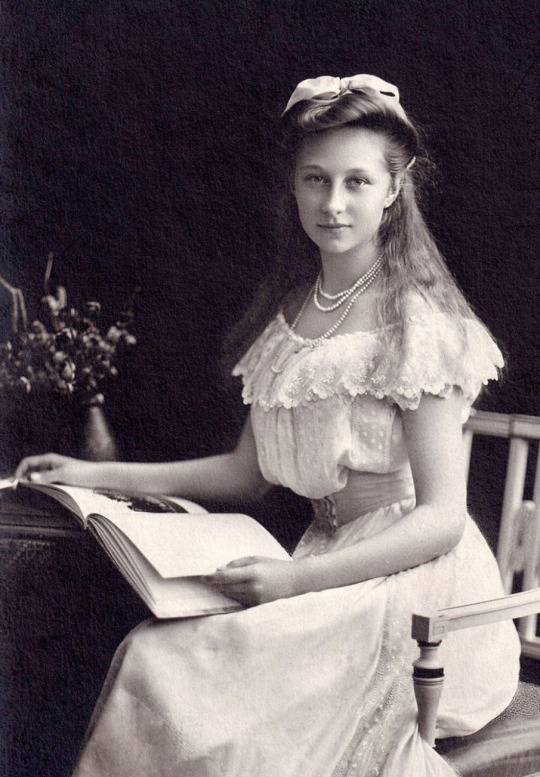
Princess Victoria Louise of Prussia
Daughter of Kaiser Wilhelm II, Great Granddaughter of Queen Victoria
1892-1980
#what a beauty!!!#🤍💗💎#princess victoria louise of prussia#princess viktoria luise of prussia#Victoria Louise of Prussia#prussian royal family#Prussia#kaiser wilhelm ii#queen victoria
35 notes
·
View notes
Text

Crown Prince Wilhelm of Prussia with his sister Victoria Louise, Duchess of Brunswick and her husband Ernest August, Duke of Brunswick
#crown prince wilhelm of prussia#princess victoria louise of germany#ernest august duke of brunswick#german imperial family#prussian royal family#hanoverian royal family#house of hohenzollern#house of hanover
8 notes
·
View notes
Text

Photograph of Prince and Princess Henry of Prussia with the Prince's brother, Kaiser Wilhelm II and others at the garden of Kieler castle, c. 1890.
#irene of hesse#irene of hesse and by rhine#louis iv#princess alice#princess alice of the united kingdom#queen victoria#prince albert#victoria#albert#victorian#victorian era#germany#hesse#rhine#prussia#princess#royal#royalty#history#portrait#photo#wilhelm ii
42 notes
·
View notes
Text

Princess Charlotte of Prussia, later Duchess of Saxe-Meiningen. Charlotte was an descendant of Queen Victoria via her mother, Victoria Princess Royal, who was the Queen's daughter. Charlotte's father was Frederick III, German Emperor; her brother later Kaiser Wilhelm II. The photo was taken in late 1860s - early 1870s!
#she is so pretty#😍💎😍#princess charlotte#charlotte of prussia#prussian royal family#german royalty#hoenzollern#house of hoenzollern#history#royal history#royal photos#prussian royal family photos#women of history#historical women#royal beauty#royal aesthetic#royal fashion#royal hair#💋🎀#💌#royal family#royal families#royal#royalty
18 notes
·
View notes